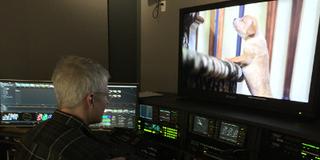Animal Planet Produces ‘Too Cute’ Series in 4K
NEW YORK — In these early days of 4K content, prestige TV series from streaming services–Netflix’s “House ofCards” and Amazon’s “Transparent”—are the likely candidates for the new high-resolution production. Reality TV doesn’t fall within those parameters, but Animal Planet’s “Too Cute” coming-of-age stories of puppies and kittens is the outlier. Four 22-minute “Too Cute” episodes have the distinction of being the first TV series to shoot and post 4K/60p.

Four 22-minute “Too Cute” episodes from Animal Planet have the distinction of being the first TV series to shoot and post 4K/60p.
“Discovery Communications has a long and established track record of being among the first to embrace emerging technologies,” said Rick Holzman general manager and executive vice president for Animal Planet. “A perfect example of this is the company’s history of being out in front of HD and 3D. It’s this culture of early adoption that led us to experimenting with 4K in two of Animal Planet’s most popular shows, ‘Too Cute’ as well as ‘River Monsters.’ We’re always interested in working with production partners who share our interest in getting a headstart with the next game-changing advance.”
AN ‘IMMENSE’ AMOUNT OF DATA
True Entertainment, an Endemol Company that also produces Bravo’s “Real Housewivesof Atlanta” and TLC’s “A Baby Story” among other reality shows, shot “Too Cute” with a single Sony F55, which generates a native 4K RAW image in a log color space. Shooting in 4K/60p presented two challenges: first is the immense amount of data generated, an estimated terabyte an hour or 2.5 times 4K 24fps. When the 4K signal is uncompressed into a DPX workflow, that hour quadrupled into 4 terabytes. Although the show’s shooting ratio, 10:1, wasn’t extreme especially for a reality show and largely because it was a one-camera show, it was still an immense amount of data: about 60 TB of original camera media and 34 LTO-6 tapes.
The second challenge is creating a workflow. For “Too Cute,” according to Prime Focus Technologies (PFT) North America President Patrick Macdonald-King, Discovery approached the company in August 2014 about the possibility of handling the dailies-through-deliveries workflow for a 4K/60p show. PFT has a history of working with Discovery on shows including “Too Cute,” which debuted in 2011; “Rocky Mountain Bounty Hunters,” “Four Weddings” and “Four Houses.”
Out of the company’s New York office, PFT managing director, operations and post production, Anthony Matt immediately turned his attention to creating a robust pipeline for the 4K/60p show. “This is our first experience taking a show from start to finish in a completely 4K workflow,” he said. “I started working with multiple companies to figure out the technology. [Editor] David Gauff and I, along with some other editors and close friends at Sony, pulled our knowledge together to figure out how to do a show at that frame rate and resolution.”
Researching tools that could work with 4K 60p turned up precious little. “We had to talk directly to the vendors about developing new tools,” said Matt. “It was a blank slate that we had to fill in, but it was exciting.”
Get the TV Tech Newsletter
The professional video industry's #1 source for news, trends and product and tech information. Sign up below.

PFT partnered with Blackmagic Design, which provided an early release of its DaVinci Resolve software that could playback 60p.
PFT partnered with Blackmagic Design, which was already working to support the format on its DaVinci Resolve. “Their software development team gave us an early release of software that can playback 60p,” said Matt. At the end of the workflow, PFT needed to encode final delivery in Sony’s XAVC codec and found support for that with Adobe Premiere. “We looked to vendors who have cloud-based software and iterate their software often,” said Matt. “Blackmagic and Adobe are both those kinds of companies; they update their software even every few weeks.”
720P ‘SATISFACTORY’ FOR OFFLINE
On-set, the Sony 4K RAW media was copied to external hard drives, which were delivered to PFT immediately after a shoot day. “We’d archive the camera originals to our large central storage, simultaneously making LTO back-up tapes for archive purposes,” said Gauff. Next, the camera media was transcoded to an Avid DNX format in 720p/60; the offline at True Entertainment was done on Avid Media Composer. “It was done as a 720p/60 project, which was critical to maintain the frames-per-second parity between offline and finishing,” he said. “Although 720p is a modified HD resolution, not the more common 1080, it was very satisfactory for offline.”
Once the edit was locked, True Entertainment sent the Avid project back to PFT, which created an AAF portable project. “The Blackmagic Resolve can understand the AAF as a sequence of clips,” explained Gauff. “Once the project was ported over, Resolve swapped out the offline proxy images for the full original 4K RAW media.”
Although the Blackmagic Resolve is more typically used for color grading, it served as a finishing station for “Too Cute.” “It was used for color grading,” said Gauff. “But it was also the only way to conform from the 4K Sony RAW camera image matching back to the 720p. I have to give a lot of credit to Blackmagic Design for integrating the Avid AAF into their workflow.
“There were some puzzles that needed to be figured out,” he added. “We integrated graphics that we were generating in Adobe After Effects and PhotoShop, and all the graphics temped in the offline process needed to be recreated at 4K resolutions, manually cut in and positioned. So there was a bit of fine-tuning that went on in the conform suite and final color correction.”
Graphics were stored in PFT’s 150-TB servers, which enabled Gauff to open them up directly in DaVinci Resolve. One specification that had to be followed was to keep the files in TFF format. “Resolve can import graphics with an alpha channel but currently TIFF is the only format that the Resolve accepts,” he said.
Matt revealed that generating deliverables was “the next interesting element.” “Once we whittled down the original media and began conforming it and color-grading it, we are then beginning to export or render out in DPX,” he explained. “We had to figure out which platforms would be able to efficiently read the DPX images as well as render out the XAVC format. Since DPX image sequences don’t have the ability to carry audio, we also had to re-synch the audio files delivered by the audio mix, and then subsequently render final files into XAVC with the audio embedded. After looking around, we found only one option that could accomplish all these tasks: Adobe Premiere. Adobe was the way to go for the rendering of the final masters.” The files were delivered on hard drive to True Entertainment, which subsequently did the packaging of the final masters themselves from hard drive to LTO.
“I was really quite surprised at how well it all worked, considering it was a process we were all inventing as we went along,” said Gauff. PFT’s Macdonald-King, Matt and Gauff declare themselves “definitely ready” for the next 4K/60p show. “We can’t wait,” said Matt. As an increasing number of content producers adopt UHD/4K, it appears they won’t have to wait long.
